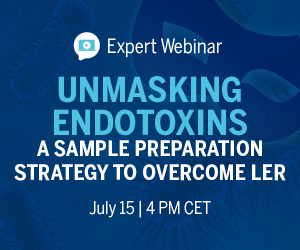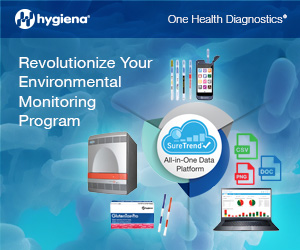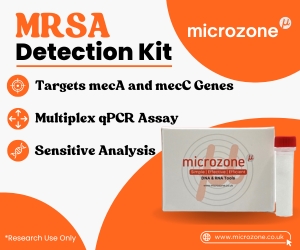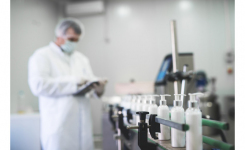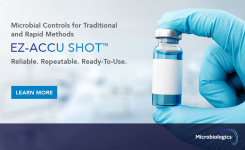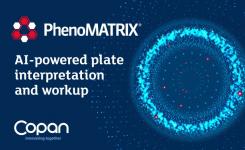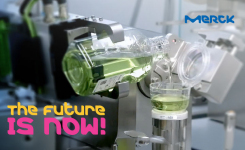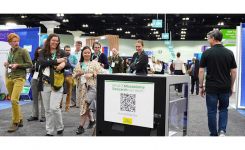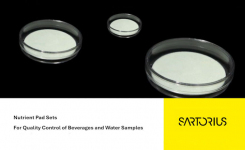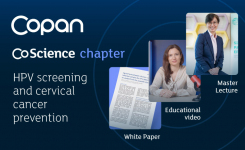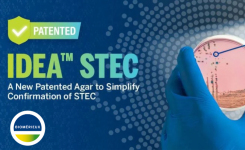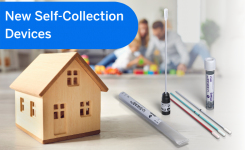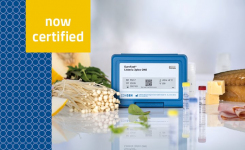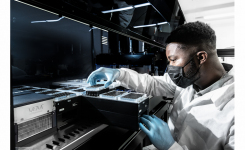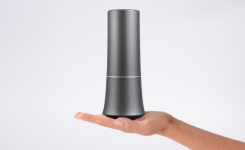
- There is considerable demand for microbiological analysis of filterable samples in manufacturing sectors other than the water industry, notably pharmaceuticals and beverages.
- Conventional methods developed for testing filterable samples may be faster than traditional plate counts, but still require relatively prolonged incubation times.
- Rapid methods, based on technology such as ATP-bioluminescence, can cut the total time required for testing by 75% or more and can also be automated.
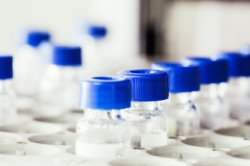 The membrane filter has been around for a surprisingly long time. The idea was first investigated in the 1850s, and a method to produce a practical version of the filter then appeared in 1918. Initially, the only application was to sterilise liquids, but microbiologists began to realise the potential that membrane filters offered and methods for testing the safety of water supplies were developed in Germany during the Second World War, with the first published methods appearing in 1947. Since then, membrane filtration methods have become a mainstay of microbiological analysis, especially in the water industry, and many different types of filter have been developed, although most of the filters used in microbiology labs are still made from cellulose acetate, cellulose nitrate, or polycarbonate.
The membrane filter has been around for a surprisingly long time. The idea was first investigated in the 1850s, and a method to produce a practical version of the filter then appeared in 1918. Initially, the only application was to sterilise liquids, but microbiologists began to realise the potential that membrane filters offered and methods for testing the safety of water supplies were developed in Germany during the Second World War, with the first published methods appearing in 1947. Since then, membrane filtration methods have become a mainstay of microbiological analysis, especially in the water industry, and many different types of filter have been developed, although most of the filters used in microbiology labs are still made from cellulose acetate, cellulose nitrate, or polycarbonate.
The big advantage that the membrane filter offers to microbiologists is the built in concentration step inherent in its use. A filter with a pore size of 0.45 µm or less can be used to retain all the viable microorganisms in a given volume of liquid, thus largely doing away with the need for enrichment cultures and cumbersome MPN (most probable number) enumeration methods. It is therefore a particularly useful technique for the analysis of liquids that are expected to contain a relatively low number of microbial cells. There are other advantages too, including eliminating the need for serial dilutions, reduced media use, shorter incubation times than standard plate counts, and the facility to rinse away inhibitory compounds, such as preservatives, in the sample without the need to add a neutraliser to the culture. The big disadvantage is the limited number of materials and products that can be induced to pass through a membrane filter without blocking the pores.
The most important application for membrane filtration in microbiological laboratories remains water testing, and this is dealt with in a separate, dedicated Method Guide. This leaves two industries where membrane filter-based methods play a significant role, pharmaceuticals and beverages. Both have a considerable demand for microbiological testing of filterable samples, and both manufacture products that are expected to contain low numbers of microorganisms. It is therefore not surprising that membrane filter-based test procedures are common in both sectors, or that rapid methods incorporating a filtration step have been developed for pharmaceutical and beverage industry applications.
Pharmaceuticals
Routine microbiological testing carried out by the pharmaceutical industry is largely determined by regulatory requirements. This applies not only to what should be tested and when, but also to the methods that should be used. For non-sterile raw materials, process intermediates and products, harmonised compendial methods are set out for microbial limit testing (enumeration of total viable counts and detection of specific microorganisms) in US, European and Japanese Pharmacopoeias. A membrane filtration method is included for enumeration of microorganisms in filterable samples, based on culturing microorganisms from the test sample.
Typically, samples are filtered through a membrane filter of a suitable pore size (0.45 or 0.2 µm) and the filters are then transferred to the surface of agar plates containing prescribed media. The filters are incubated to allow visible colonies to develop, before the colonies are counted and the result calculated. For the total aerobic microbial count, filters must be incubated for 48-72 hours, but a total yeast and mould count requires a minimum of 5-7 days incubation. These long incubation times have inevitably generated increased interest in rapid microbiological methods (RMM) using the advantages of membrane filtration to prepare the sample, but with faster detection of microorganisms to cut the total test time.
Rapid Methods
The main barrier preventing the introduction of RMM into the pharmaceutical industry has traditionally been validation within the regulatory environment. But the current shift towards parametric product release and a ‘quality by design’, risk-based approach for product and process development is changing this situation. For example, the Process Analytical Technology (PAT) approach supported by the FDA and other regulatory agencies aims to enhance process understanding by harnessing modern analytical technology, together with information management and analysis tools. Traditional culture-based microbiological analysis techniques are of very limited value in PAT – they simply take far too long to produce a result. The growing need to provide timely microbiological data for product release and continuous process monitoring has prompted microbiologists to look towards RMM as a solution. This has been helped by the publication of detailed guidance on validation methodology, such as that included in the PDA Technical Report 33. As a result, there are now a number of commercial test systems and kits based on membrane filter technology that are available for use in the pharmaceutical industry.
Autofluorescence detection All living cells produce a small amount of fluorescence (autofluorescence) and this can be used to detect microbial colonies growing on a solid surface long before they are visible to the naked eye. This technique is particularly useful for filterable samples, where a membrane filter can be incubated on a conventional nutrient medium and scanned using highly sensitive imaging systems to detect microcolonies, sometimes several days earlier than using traditional colony counting methods.Autofluorescence detection has been commercialised by Rapid Micro Biosystems as Growth Direct™, which uses a large area CCD imaging system without magnification to detect developing microcolonies. The system has the advantage that it is non-destructive and easy to validate.
ATP-bioluminescence Adenosine triphosphate (ATP) bioluminescence is a well established RMM for assessing contamination levels in pharmaceutical products and raw materials. It utilises a specific substrate and enzyme combination, luciferin/luciferase, to break down microbial ATP from growing cells and produce visible light, which can be measured using a luminometer. The amount of light is related to the number of microbial cells present. The main drawback is that non-microbial ATP is also detected.Several commercial systems have been developed for pharmaceutical test applications, notably presence/absence microbial limit testing and enumeration, and are especially useful for filterable samples where non-microbial ATP in the sample is less of a concern. By filtering sufficient volume, the need for an enrichment step, often required where low numbers of organisms are present, can be reduced. ATP-bioluminescence tests typically require less than 24 hours to obtain a result even when samples are expected to be virtually free of microorganisms. Where higher counts are acceptable, or large volumes can be filtered, results can be available in a few minutes. Examples of products that can be used with filterable samples include the Celsis Advance system using its’ RapiScreen™ reagents and an ‘enhanced’ ATP bioluminescence assay, AMPiScreen™, which utilises proprietary enzyme technology to increase the quantity of microbial ATP produced and reduce detection times by 25-50%.
The Milliflex® Rapid Microbiology Detection and Enumeration system from Millipore also uses ATP-bioluminescence to detect microbial cells and is designed specifically for monitoring microbial contamination in filterable samples. It is an automated system, which employs image analysis technology to detect microcolonies growing directly on the surface of a membrane filter after the addition of bioluminescence reagents. On-board software then displays the result in CFU for comparison with conventional test methods. Detection times are said to be quarter of those required by standard methods.
Cytometry Systems Solid-phase cytometry technology can be used to detect viable microorganisms directly on the surface of membrane filters. Typically, the cells are labelled using a fluorescent dye or a non-fluorescent substrate, which is converted to a fluorochrome in viable cells. Detection of the labelled cells occurs by laser scanning on a solid phase platform, in this case a membrane filter. Results are available in 3-4 minutes after sample preparation.
Solid phase cytometry detection systems for filterable samples are commercially available from bioMérieux, which has developed the Scan®RDI (also known as ChemScan RDI) system to detect viable cells on membrane filters.
A non-culture-based technology used in food microbiology is flow cytometry. The bioMérieux Chemunex range of Flow Cytometry Analysers use a fluorescent labelling technique to detect viable cells directly in liquids by flow cytometry. Unless the microbial population is very low, no enrichment of the sample is required and results can be obtained in hours rather than days. Chemunex technology from bioMérieux provides rapid detection of Total Viable Count, Yeast and Molds in a wide range of filterable beverages, iced teas, flavoured waters, energy and sport drinks.
Molecular Methods Molecular biology-based microbial detection systems have been making rapid progress in the clinical and food microbiology sectors and are now also being developed for pharmaceutical applications. The most commonly used technique to date is the polymerise chain reaction (PCR), which targets and amplifies specific sections of microbial nucleic acids to provide a highly specific detection technique, which, in the case of real-time PCR where amplification and detection are simultaneous, can produce results in a few hours. Many commercial PCR systems target specific microbial species, such as Salmonella, but there are also products aimed at the pharmaceutical industry, which are able to detect a much wider range of contaminants.
PCR-based systems designed to detect specified microorganisms in filterable samples have been developed.
Beverages
The requirements for microbiological testing in the beverage industry are very different. The regulatory influence is far less prescriptive and flexible, provided that safe products can be ensured. The emphasis is very much on potential spoilage organisms. In many cases the acidity and/or alcohol content of drinks limits the species likely to cause spoilage. Microfungi, especially yeasts, are a particular concern, while specialist spoilage bacteria, such as lactobacilli, Oenococcus and Gluconobacter, are an issue for beer and wine manufacturers.
Since the majority of beverages can be membrane filtered, filtration-based methods are commonly used for quality assurance purposes. As with pharmaceuticals, methods typically involve filtering samples and incubating the filter on suitable selective or non-selective culture media for several days before examining the filter for visible microbial colonies. Once again, it is the lengthy incubation step that causes a bottleneck in the process, potentially delaying product release. This has driven the development of some filtration-based RMM with applications in the beverage industry.
Rapid Methods for Beverages A number of the systems described above can be adapted for use with beverages and some suppliers have developed test protocols for beverage applications. However, there are also a few products that have been developed specifically for use in the beverage industry.
One example is the Celsis Innovate ATP-bioluminescence based system, which is designed for both dairy and beverage applications. It uses the same reagents as the company’s Advance system, but in a platform adapted for the demands of the beverage industry and with dedicated software capable of dealing with high volume products.
Another system designed with the beverage industry in mind is Millipore’s BeviStat™ Rapid Microbiology Detection System. BeviStat is automated and designed to detect yeasts and moulds in filterable samples in minutes using ATP-bioluminescence technology. It can also detect low levels of bacteria if an incubation step is included.


